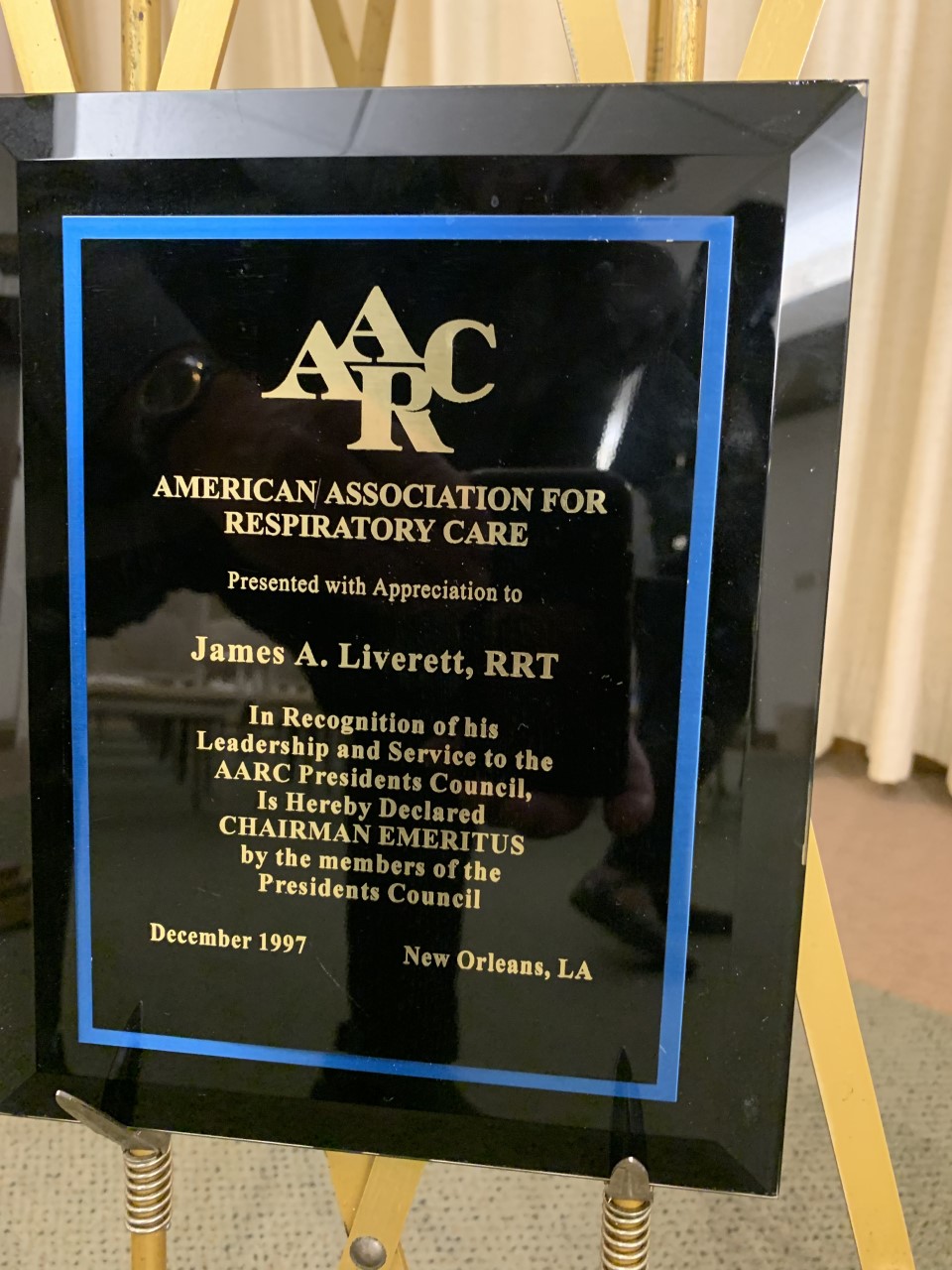
The AARC’s 1972 president, Jim Liverett, BSRC, RRT, passed away in May, leaving behind a distinguished record of service in the Association and the profession of respiratory care.
Former AARC Executive Director Sam Giordano, MBA, RRT, FAARC, recalls the pivotal role Liverett played in moving the profession forward during its time of exponential growth.
“During Jim’s tenure as an AARC leader, respect for our profession grew and scope of practice was expanded, which led to a name change from ‘inhalation therapy’ to ‘respiratory care,’” said Giordano.
Trailblazer for the profession
 Jim Liverett AARC Presidential Photograph.
Jim Liverett AARC Presidential Photograph.Jim Liverett truly was a pioneering member of the profession, beginning his career at Georgetown University Hospital in Washington, DC, after serving in the Army for two years. Most of his working years, however, were spent in New Orleans, LA.
Duke Johns, who met Liverett after he moved to New Orleans in 1967, remembers their first encounter. It took place shortly after the welding company Johns worked for decided they wanted to leverage their oxygen know-how to get into a brand new business — supplying medical products — and asked Johns to lead the way.
“Jim Liverett was the director of the inhalation therapy department at Touro Infirmary,” he recalled. “It was the only hospital in New Orleans that had a full time medical director for their inhalation therapy department.”
The welding company decided it would be a great place to start when it came to getting up to speed on medical oxygen and associated products, and Johns was assigned to gather the information. “I went to Touro and asked to shadow his department and learn because I was going to start being a supply person,” he said.
After about a week in the department, during which time he submitted himself to some of the same tests and procedures patients went through, Johns began a career in respiratory specialty sales, and later home care, that continues to this day.
Liverett made sure he learned what he needed to know, and then some. The first thing he told him was, “If you are going to work with us and sell to us, you have to be one of us. You have to join the AAIT.” Johns has been an associate member for 54 years.
A mechanical genius
As time marched on, Johns was a first-hand witness to the influence Liverett had on the RT community in Louisiana. From hosting registry courses for therapists interested in sitting for the registry exam (free of charge) to starting an educational program at St. Mary’s Dominican College, he says the future of the profession was always Liverett’s top concern.
His love of respiratory technology was legendary as well. Johns regularly took advantage of it by taking new equipment to Liverett to find out if it was worth offering to his customers. “He was a mechanical genius,” he said. “He could fix anything. You could trust in his judgement and his evaluation.”
Liverett was a trailblazer for the profession in terms of new procedures as well. “He was the leader in things no one else was doing, such as arterial sticks,” said Johns. “He was the first to have RTs approved to perform intubation in our area — he got his people trained. And he was the first to put RTs in other areas besides the floors and ICUs. He got them into the ED, outpatient places, and staffing OB and the PACU.”
Merging two credentialing bodies into one
Liverett was an active member of the AARC and the Louisiana Society for Respiratory Care throughout it all, and his service culminated in 1972 when he took over as AARC president.
His term came during a time when the need for RTs was growing by leaps and bounds. Several years prior, the Association had established the AART Technician Certification Board to offer a credential to therapists who were working in the profession but did not qualify to sit for the RRT exam.
By 1972, thousands of therapists had taken advantage of it by earning the Certified Respiratory Therapy Technician credential. Liverett thought it was time to bring the program under the auspices of the American Registry of Inhalation Therapists and made it his mission to do just that during his term in office.
He is widely credited with helping to foster the ultimate merger between the two credentialing arms of the profession, which combined to become the National Board for Respiratory Therapy in 1974.
A willing mentor
Sam Giordano, who served as AARC president in 1980 before taking on the role of executive director, remembers Liverett as a seasoned veteran of the profession who was willing and able to mentor younger people who were just coming up, like he was in those days.
 Jim Liverett was proclaimed chairman emeritus of the AARC President’s Council in 1997. This plaque was on proud display at his funeral.
Jim Liverett was proclaimed chairman emeritus of the AARC President’s Council in 1997. This plaque was on proud display at his funeral.“Perhaps the most profound contribution Jim and others of his generation provided was to make sure younger leaders understood that AARC leadership was about giving more than you get when in a leadership position,” he said. “He made it clear that future AARC leaders need to understand that they’ll have to sacrifice in order to serve the profession, but always keep the best interests of our patients top of mind. If it wasn’t for Jim’s support and friendship, I know I would not have succeeded.”
One area where he says Liverett made an especially significant impact was on the ability of RTs to work on a collaborative basis with other health care providers and earn their respect for the profession and what it could offer to health care as a whole.
“Jim had vision for an expanded scope of practice and he, along with Jimmy Young and others, fought to achieve this goal,” said Giordano. “Our school system was still relatively young, and Jim was one of our AARC leaders who helped guide CoARC’s predecessor towards gradual expansion of our formal education system, as well as the transition from OJT as entry to the profession to requiring formal education from accredited education programs.”
Liverett and the small band of like-minded therapists who worked with him effectively made the pivot without disenfranchising the then current workforce, continued Giordano.
A legacy to celebrate
The AARC honored Jim Liverett with its highest honor, the Jimmy A. Young Medal, in 1982, and made him a Life Member as well. The Association joins all his long-time friends and colleagues in mourning his loss and celebrating the legacy he left behind for all the RTs who came after him.
Email newsroom@aarc.org with questions or comments, we’d love to hear from you.














